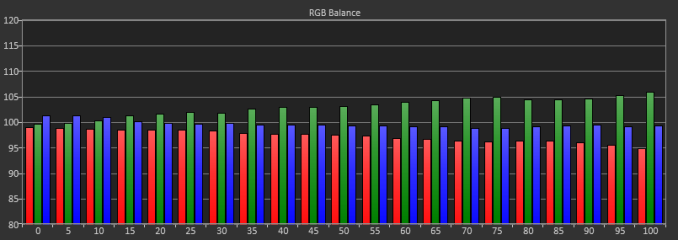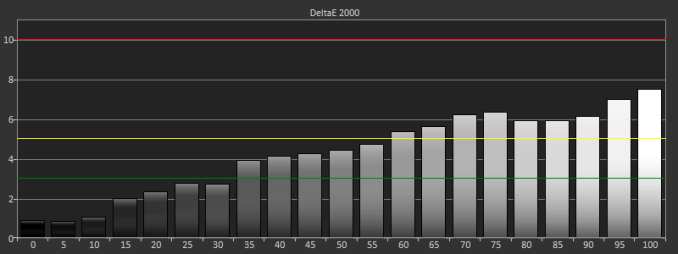Dell U3014 LCD Review
by Chris Heinonen on April 15, 2013 2:00 PM ESTThe U3014 ships with a copy of Dell UltraSharp Color Calibration Solution on the CD but doesn’t include the necessary hardware. For this you actually need to buy an i1Display Pro meter, though you can order it off Amazon or anywhere else and not just directly from Dell. One thing to note is that you need to use the retail i1DisplayPro meter and not the OEM version, as they have a different hardware ID and companies have to buy the licenses for each type separately from X-Rite. For 99% of you this won’t be an issue, but it meant my i1DisplayPro didn’t work as it’s an OEM one that some calibration software requires, and so Dell provided me with a brand new one. This is really an X-Rite issue as they added this restrictive licensing that didn’t exist on their old hardware, but it’s something to be aware of.
Using the Color Calibration Solution is really quite easy. You hook up the i1DisplayPro meter, choose your targets, and let it work. You can set up two custom settings in the CAL1 and CAL2 settings on the monitor, and you can choose from common colorspaces or a custom one. This makes it very easy to set up an sRGB and AdobeRGB calibration, Day and Night calibrations, or any other combination. One thing I wish Dell did let you do was rename them in the display, as Day and Night would be easier to remember than CAL1 and CAL2.
Dell also needs to provide some post-calibration measurements showing the difference from before and after. LGs calibration package does this, but the Dell software just finishes and installs the profile with no numbers, charts, or side-by-side examples to show you what it did. One would assume it gets very close to the target, but you really have no idea at all unless you measure with another software package. That’s mighty inconvenient to have to do.
The main issue I have with the Dell software, which we will see shortly, is that it only supports the i1DisplayPro. Being a colorimeter and not a spectrometer, the i1DisplayPro is very good at reading levels of light but can be confused by irregular wavelengths of light. Since the U3014 uses a brand new G-B LED array that has different wavelengths than most monitors, that means the i1DisplayPro is likely to interpret data from it incorrectly unless it has a custom response table built for each individual meter. With the U3014 aiming directly at the upper-end of the marketplace, it needs to include support for spectrometers like the i1Pro as well to do a better job calibrating it.
To show the difference this makes, I made three sets of measurements after the Dell software finished its calibration. The first set is using the i1DisplayPro that the software uses to do the calibration. The second is using an i1Pro meter, which is a spectrometer. The third is using a C6 colorimeter, which is basically a slightly customized i1DisplayPro, but which has been profiled in CalMAN using the i1Pro so it knows how to read the light spectrum from the U3014.
First up, let’s look at the grayscale numbers. Using the i1DisplayPro, we see there is a heavy green shift, with a bit of blue at times, and red is really low. However, if we switch to the i1Pro or the profiled C6, we see that red and green are high and blue is low. Our average CCT switches from 6826K, a blue tint, to 6325K, a reddish tint. If you’re comparing results and it’s not a very dark screen (below 10 cd/m2), the spectrometer is going to be correct, not the colorimeter. Here we see that the Dell software might think it’s getting a better result than it is, because the i1DisplayPro can’t read the light output properly.

Looking at the Grayscale dE2000 data, we actually see a huge error when only using the i1DisplayPro, with an average dE of 4.3 whereas the C6 and i1Pro see errors of 1.99 and 2.12 respectively. I lean to the C6 numbers over the i1Pro as it can read 20% and below much better, which means that data is going to be more accurate. We still see that we get totally different results from the same screen using the different meters, and we get worse data from the i1DisplayPro itself, which I didn’t expect to see.

This carries over into the Gretag Macbeth charts as well, where we see a much higher average dE2000 (2.96) with the i1DisplayPro than we do with the C6 (1.59) or the i1Pro (1.68). This is mostly grayscale error, but skin tones and oranges in particular are also poor. It might be that those wavelengths are the ones the i1DisplayPro has trouble reading correctly, and so its picking up less red than it should. This would account for almost all of these issues, but it still shows the problems with only using a single colorimeter that hasn’t been profiled for the display it is being used on. These problems only grow as you use custom backlights that have a new spectral signature.

In the end, the Dell software gets you closer than the default, and if you have an i1DisplayPro that you can use I’d go ahead and use it. However, if you have access to something like an i1Pro or other spectrometer, you could use ArgyllCMS and one of the free front ends like dispcalGUI to get better results because it can read the light correctly. If Dell can add support for the i1Pro or another spectrometer, or even better allow you to profile the i1DisplayPro off an i1Pro, then their software would be very nice to use. Considering its free, this might seem like a lot of complaints, but I wouldn’t want someone to buy the U3014, use the software and their suggested meter, and think they have a perfectly calibrated display when we can see that isn’t actually the case.
















84 Comments
View All Comments
airmantharp - Monday, April 15, 2013 - link
We have four, and they're all 'responsive', but don't go labeling them as 'ergonomic'. Still, since you rarely perform complex settings adjustments after initial setup, they're probably a better choice for longevity over cheap mechanical buttons that may wear out.cheinonen - Monday, April 15, 2013 - link
I didn't test the U3011, but the U2713HM and other Dells that I have tested have had the actual buttons, which I love. I wish they kept it that way, looks be damned.p05esto - Monday, April 15, 2013 - link
Yea, I have the U2713HM and like the phyiscal buttons. I hate all the "touch" controls companies try to shove down our throats. Nothing beats pyysically raised buttons with tactical feedback when pushed. This goes for just about any gadget. Cameras with touchscreens are soooo useless for example.chubbypanda - Monday, April 15, 2013 - link
Aging Dell U2410 also has touch buttons (with motion detection) and real power on/off button. Kind of annoying, but it's bearable. Looks better than physical buttons on U2412M of course (the overall design is better actually).blau808 - Monday, April 15, 2013 - link
I have/had the U3014 and the U2410. The U3014's touch sensitive buttons are anything but. Sometimes it takes 2 or 3 touches to get it to activate whereas on my U2410 I never had a problem with the touch sensitivity. So they changed something that put them a step back from their previous solutions it seems.blau808 - Monday, April 15, 2013 - link
I recently purchased one of these and am now in the process of sending it back. While changing any of the preset mode (game, multimedia, etc) the monitor turns to severe static and artifacting. In standard preset mode, the reds seem to flash on and off turning the screen a bluish tinge before flashing back to normal. I am truly disappointed and keep telling myself thats what I get for being an early adopter. Hopefully the next panel I get wont be a dud.CSMR - Monday, April 15, 2013 - link
Excellent to see continued progress in monitors.One question is why the review focused more on sRGB and AdobeRGB modes than Standard? The usual advice is to always have the monitor on Standard and let Windows do all the color conversion.
cheinonen - Tuesday, April 16, 2013 - link
If you use Standard mode, you aren't certain what the gamut that its using is (probably a larger one than sRGB), and then you're dependent on Windows to manage colors, which means you need to have both an accurate ICC profile, and every application to be ICC aware. sRGB will force the monitor to use the proper gamut for 99% of things (very little properly uses AdobeRGB, but for those people that need it, it's essential) and you don't need to have Windows and the applications be ICC aware.CSMR - Tuesday, April 16, 2013 - link
Getting this monitor and using sRGB would be a real waste. People who buy monitors like this know that they want a wide gamut and precise calibration. Yes there are some applications that are not color aware and give wrong colors on a calibrated monitor, but 1. these applications are not color critical or else they would be ICC aware, and 2. the gamut would be right as that is done via a global setting (LUT) in the graphics driver.cheinonen - Thursday, April 18, 2013 - link
And that's why there are multiple calibration modes available that you can save, as well as included software that will switch the display between those modes when working in the correct application. So if Photoshop requires AdobeRGB and Premiere needs sRGB, you can have the monitor switch on-the-fly between those two.Of course, if the included calibration software worked better, so you could have more accurately calibrated modes saved to the CAL1 and CAL2 presets, that feature would work even better.